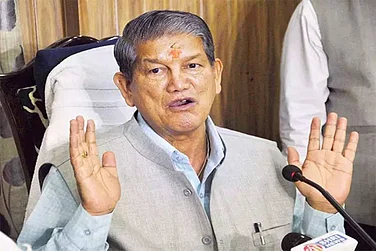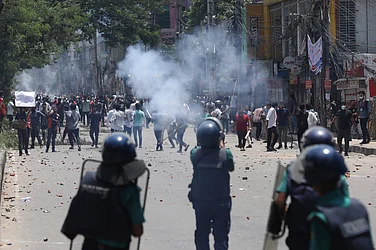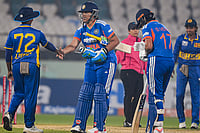Two months after seven-year-old student Pradyuman Thakur was found with his throat slit in the washroom of Ryan International in Gurgaon, the Central Bureau of Investigation (CBI) announced the arrest of a Class XI student of the same school for his murder.
The minor’s arrest for the heinous crime came as a shocker because the Gurgaon police, earlier investigating the case, was armed with a “confession” by the school’s bus conductor Ashok Kumar. It was even ready to file a chargesheet when the CBI was handed over the probe. A CBI spokesperson says the agency narrowed the probe down to the 16-year-old accused on the basis of CCTV footage besides forensic and scientific evidence. He offers no comments on how the local police caught the wrong person even when the September 8 footage shows the Class XI boy entering the washroom with Pradyuman.
This is not the first case the police have botched up. The rape and murder case of a minor schoolgirl in Shimla four months ago is one such. With the CBI handling that case now, eight cops, including an inspector-general, are in jail for an attempted cover-up job.
The CBI is now struggling with a case where one of the accused had died in police custody and the crucial evidence perhaps lost forever. The agency is preparing for a narco test on the five other accused, who are out on bail. The accused, including a close relative of the Himachal Pradesh law officer, were granted bail as the CBI failed to file a chargesheet in the case. “There isn’t watertight evidence to present in the court,” says a senior CBI official. “Even if we do file a chargesheet, it will not stand scrutiny in the court and the case will be thrown out. It is a pity that we have to rely on lie detector and narco tests to solve cases. These are just tools to corroborate evidence and not even admissible in court.”
The courts have time and again questioned the standard of investigation and pulled up the police for shoddy probes—in many cases implying wilful negligence and collusion. Result: poor rate of conviction. Last year, appalled by the abysmal conviction rate of just about 20 per cent in past five years, a Delhi Court came down heavily on Delhi Police, pointing out that “innocents may have been sent for trial and guilty gone unpunished” because of its lackadaisical approach.
“Then court is blamed for acquittals that allowed culprit to go scot-free,” the court noted in a strong indictment of quality of investigation. “But the reason is shoddy police investigation. It means they have apprehended a criminal but because of poor quality of investigation and evidence, court acquits the criminal...because of shoddy investigation, innocent people get arrested.”
While 80 per cent of criminal cases decided by the Delhi High Court ended in acquittal, the figure hovered around 60 per cent for the capital’s sessions courts in the past five years. As per the National Crime Records Bureau, the nationwide conviction rate for violent and sexual crimes for 2015 was just about 36 per cent.
In view of the “revealing statistics”, the High Court bench of justices B.D. Ahmed and Sanjeev Sachdeva reiterate what all law enforcement and investigating agencies have heard often from various committees on reforming criminal justice system but consistently failed to implement. “For this reason, we have been pressing upon the need to bifurcate law and order duties so that investigation wing improves. We also stressed the need for proper scientific methodology, increase in manpower but these concerns take a back seat for governments of the day.”
The High Court, in its scathing observations, summed up what ails the criminal justice system in the country: poor investigations, lack of forensic support with poor infrastructure and a dearth of trained staff. Outlook spoke to a cross-section of experts, who form a part of the system, and found inadequate or outdated forensic techniques as the main cause of botched-up probe, leading to a domino effect on the outcome of the case. Lack of modern forensic support leads to poor investigations that in turn provides inadequate evidence to the prosecutor to present the case in court with the result it does not stand scrutiny of law.
The Sunanda Pushkar case is perhaps a classic example where several questionable forensic tests have only served to confuse investigations. In view of contradictory reports, the Delhi Police has failed to file a chargesheet or even conclusively say whether the wife of politician-writer Shashi Tharoor was murdered or if she committed suicide or died accidentally. As a last-ditch effort, the police have requested to employ “forensic psychology”.
Additional Solicitor General Sanjay Jain, who appeared for Delhi Police in the Delhi High Court, says that this new tool of investigation, which relates also to the personal questioning of certain individuals, is being resorted to ensure that “no stone is left unturned”. It is a peculiar case, he says, since nobody is an accused and nobody from the family has made any allegations. Generally, in a case where forensic experts give inconclusive report, no FIR is registered. However, here, the case was registered after one year of death and probe had to be carried out. According to Jain, over 90 persons have been questioned and help of forensic experts has been sought on seven occasions but nobody has given a conclusive opinion so far.
Forensic experts from AIIMS, where the first autopsy was conducted, Central Forensic Science Laboratory (CFSL) and even from FBI carried out viscera examination but none could establish anything conclusive. Senior advocate Vikas Pahwa, who is representing Sunanda’s son Shiv in the court, says they agreed to the use of forensic psychology in the interest of justice. “Shiv’s view is that ‘please do whatever you want to investigate but nobody should try and draw political mileage from it’,” says Pahwa.
On the larger issue of forensics, he says the investigating tools are very primitive. “The world over, investigating agencies are using forensic experts for almost everything: handwriting analysis, voice samples, DNA profiling and auditing account books in white-collared crimes like money-laundering. Here, we don’t even do the basic of securing the crime scene,” shrugs Pahwa, citing the example of Aarushi Talwar case where the crime scene was trampled upon by all and sundry. The parents of the Noida girl, who was 13 when she was killed in 2008, may have been acquitted after being held guilty by a lower court but nobody still knows who killed her and servant Hemraj Banjade, 45. “This case is among the biggest failures of our criminal justice system where both the local police and the CBI failed to catch the culprit,” he adds.
Former DCP of Special Cell, Delhi Police, L.N. Rao gives the run-down on how a case should be ideally probed. “Cordoning off and securing the crime scene, photographing the spot before touching it, looking for physical evidences, lifting evidences including fingerprints, seizing and sealing the evidence, preparing seizure memo, collecting oral evidence in form of statement of witnesses, if any, registration of FIR and then beginning of investigation,” he says. If there is an injured person on the spot—be it a victim or suspect—he/she should be rushed to the hospital and questioned as soon as possible.
However, reality is far removed from the ideal. “Lifting of fingerprints, or even looking for them, is seldom done,” reveals a senior police official. “It is painstaking and entails poring over reams of data to look for a match. Only those cases that become high-profile and get media attention get properly investigated, even if it is after initial botch-ups. By then, it is generally too late.”
Collection of samples is not done properly since most police personnel are not well-trained. The samples picked up in the 1996 Priyadarshini Mattoo murder case had become putrid as they had not been sealed properly. Additional Sessions Judge G.P. Thareja, while acquitting accused Santosh Kumar, son of a senior IPS officer, had said he knew “he (Santosh) is the man who committed the crime,” but he was forced to acquit him for want of proper evidence. The High Court overturned the judgment, observing that “the trial judge acquitted the accused amazingly taking a perverse approach. It murdered justice and shocked judicial conscience.”
In a similar case, the High Court had overturned the judgment of the trial court in the Jessica Lal murder case where the accused Manu Sharma had initially been acquitted. Like in the Mattoo case, the accused was influential and forensic evidence in the form of ballistic report was used to obfuscate the investigations. Manu was acquitted by trial judge S.L. Bhayana in February 2006 as a two-weapon theory was floated by Forensic Science Laboratory (FSL) ballistic expert Roop Singh.
The judge had observed that the court has acquitted them because the Delhi police failed to sustain the grounds on which they had built up their case. “The police failed to recover the weapon which was used to fire at Jessica Lal as well as prove their theory that the two cartridges, emptied shells of which were recovered from the spot, were fired from one weapon.” Later, as the High Court overturned Justice Bhayana’s judgement, it also questioned Roop’s dubious role in the investigations. The ballistic expert came under a cloud once again as he was found to have “fabricated” the report in the case of infamous 1997 Connaught Place encounter in which Delhi Police’s 10 personnel were convicted for killing two businessmen.
Sudhir Gupta of AIIMS, who heads the institute’s department of forensic medicine and toxicology, rues the fact that forensic opinions have become questionable. “The opinion from forensic experts should be of gold standard; it can help in solving cases and not confusing them,” he says. However, he adds, “the situation on ground is shocking to say the least. There are too few forensic labs, too many cases leading to a huge pendency and pressure on the existing labs.”
There are only seven CFSL branches in the country, operating under ministry of home affairs out of which only three are working to full potential, in addition to rudimentary regional labs in some of the states. “There is pendency of 3,500 to 5,000 cases in each lab at any given time,” says the senior police official. “With long delays, the samples get putrefied, reducing chances of detection. Samples including those of blood and semen are kept in malkhanas, most of them without ACs. Seals are broken. How can one expect an accurate result in such a scenario?”
Dr Gupta suggests that the police, doctors conducting autopsies and forensic experts should work in tandem. “It must be a seamless operation. Testing of samples should be immediate as preservatives can alter them,” he says. “The forensic report should come before the post-mortem is completed so that the cause of death can be included in the report. Each hospital like AIIMS can have its own FSL facility.” He counts identification of Sheena Bora, allegedly murdered by her mother Indrani Mukerjea, a former media executive, from a heap of burnt bones as one of his team’s finest works.
Former AIIMS director T.D. Dogra, now Vice Chancellor of SGT University, had conducted the post-mortem of the then prime minister Indira Gandhi. He says forensic services in the country are not well organised and lack in central planning. According to him, proper training is not available in the field and varsities must offer specialised courses. Currently, very few institutions, including Gujarat Forensic Sciences University, offer courses in the field. He had worked on cases like Nithari killings, Naina Sahni murder, Bhanwari Devi killing and Bilkis Bano case. With so much pressure on government labs, Dr Dogra suggests using services of private labs like the Truth lab.
The police, in fact, have been using the Truth lab in several cases. Director of Truth labs, G.V.H.V. Prasad, tells Outlook that they have been working with investigating agencies in several cases including those which require examination of handwriting, CDs, voice identification, polygraph and DNA fingerprinting. “We have worked in some high-profile cases like the Mulayam Singh-Amar Singh CDs and N.D. Tiwari paternity case,” says Prasad. He recounts how soon after Tiwari inaugurated their Hyderabad lab as Andhra Pradesh governor, his sample came to them for DNA testing. “Our report in the case was clinching,” he adds. Reports of private labs are admissible in court under Section 45 of Evidence Act as expert opinion.
The case of Mulayam Singh CD is another classic case of conflicting forensic reports. When the Special Cell of Delhi police, investigating the case, first sent the CD to CFSL in Delhi, it said the tape was not edited. However, then home minister P. Chidambaram was apparently not satisfied and wanted a second opinion. It was then sent to Chandigarh’s CFSL, which said it was edited.
In view of the conflicting opinion, lawyer Shanti Bhushan sent it to Truth lab and also a US lab. His allegation: Amar Singh was behind the editing and circulation of the CDs. Both said it was indeed edited. The police also sent it to government-run CERT-In (Computer Emergency Response Team) that gave the verdict of not edited. Taking advantage of contradictory reports, the Special Cell closed the case as “untraced” with findings that the CD was edited and also unedited! It said the CDs “are probably the copies of an edited CD prepared by someone on different occasions/sessions.”


























